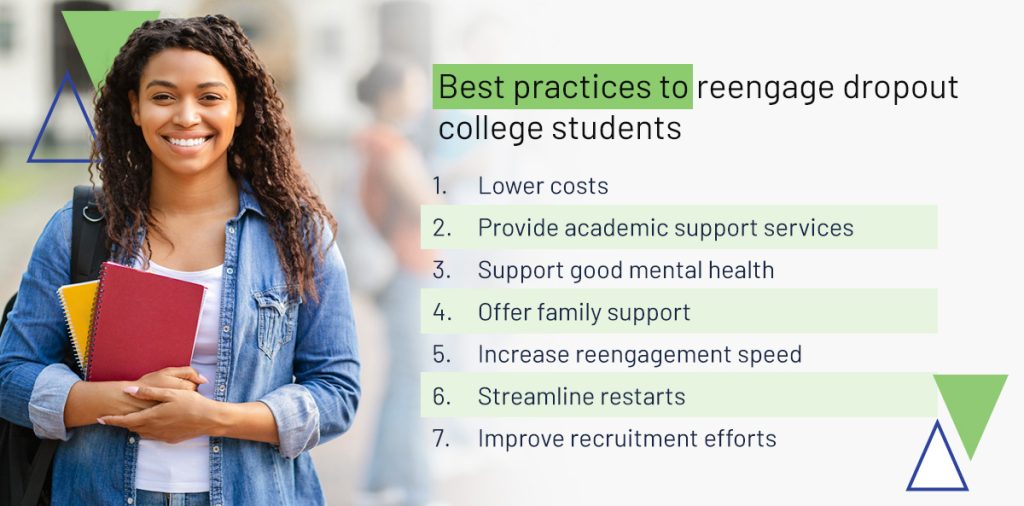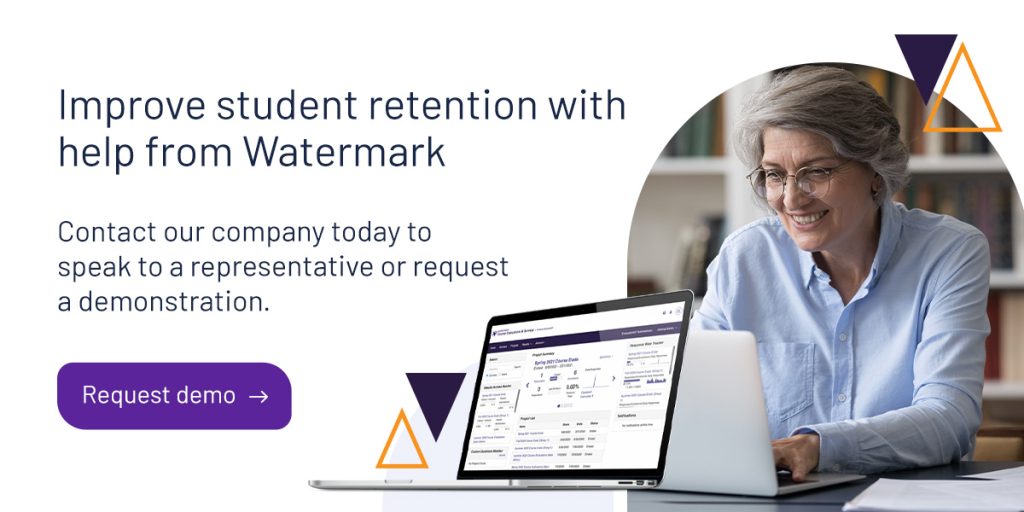




Student dropouts have become common among colleges, especially as tuition prices and the cost of living rise. The more community college administrators work to understand the reasons for student withdrawals, the more they can prevent dropouts through effective programming and services for student engagement.
This guide explores six reasons why students leave community college. We also cover best practices for reengaging dropout college students and improving retention.
Community college students drop out of school or classes for several reasons. From insufficient finances to a need for more community or acceptance at school, various social, economic, or emotional causes contribute to withdrawal. Here are the top six reasons students drop out of college.
Many first-generation college students or those from low-income families do not have the funds to pay their way through college. Even with the assistance of student loans, the money might not be enough to cover basic costs for books, supplies, or a meal plan. As tuition costs increase, many students must work full-time to pay for college or support their families.
Sallie Mae’s survey about college completion trends shows that 50 percent of students find it challenging to pay for additional costs like living expenses, food, and books. Fifty-three percent of students struggle to meet tuition costs. The survey shows that 33 percent of students from low-income families have higher risk factors than those from middle- or high-income families. First-generation students who participated in the survey were also 41 percent more likely to consider leaving college or face a dismissal risk.
While colleges might think they offer enough money in loans and scholarships, many do not. The inability to pay for college often causes students to drop out. Alternatively, those applying for loans or financing might become overwhelmed and give up on reapplying. According to the survey, 30 percent of students think about dropping out due to financial challenges.
Another reason college students drop out is a lack of time. Creating a healthy work-life balance is hard enough. Adding schoolwork on top can be the breaking point for a student who doesn’t have time for their projects, activities, and work responsibilities.
Staying on top of lectures, tests, and studying can become stressful for students who don’t know how to manage their time. Because college requires a commitment of several years, many students might not think the time and effort are worth the anxiety and burnout. Either life, work, or health will get in the way.
Many students left community college before the fall of 2023 with some credit but no credentials or degree. A study from New America states that 49 percent of these students cite having to work as a major reason for their departure. This was the biggest factor established out of 14 main reasons students decided not to reenroll.
In other cases, students cannot commit to the commuting distance between their home and college. For those who live far away, the responsibilities of gas, car maintenance, and driving time might prove too much.
Sometimes, the social dynamics of college hinder students from enjoying their time at school. Whether due to bad experiences or a lack of community and friendship, campus life comes with many pressures to fit in and find good peer relationships. Some students also feel the pressure to outperform their peers academically, leading to anxiety or stress over comparisons and inadequacy.
Many nontraditional students may struggle to fit in with the college lifestyle and social scene due to their age or unique situation. While creating good relationships with students and finding community through extracurricular activities can be challenging, it is crucial to fostering a comfortable and welcoming learning environment.
Research shows that open conversations about socioeconomic differences can dramatically impact the college transition and success of first-generation students. In a study where randomly selected students attended a panel discussion, they shared their individual stories about adjusting to college. They highlighted their socioeconomic backgrounds in relation to social engagement, stress, anxiety, and academic achievement. After speaking about these experiences, students felt more understood and confident as people began to appreciate and maintain awareness of these differences.
College is a significant commitment for all kinds of students. When the pressure of college overwhelms students, it is harder to accomplish their goals. A support system to guide and advise students can make a huge difference for those considering dropping out. While friends and family can offer good support, having access to mentors, peers, and academic advisors is essential to any student’s success.
Even if your college does have support services, are your students aware of them? One New America study on community college support services showed that many students who dropped out were unaware of school support systems offered by their institution. These include offerings like mental health support, basic needs, internet access, career services, and academic support. Regarding financial support, 41 percent of students who dropped out are unsure whether their former institution offered financial aid.
The challenge of academics is another reason why students drop out of community college. College coursework can be challenging, and students need many resources and assistance to succeed and graduate. Those who do not meet academic requirements might be tempted to drop out before they can make positive improvements.
One Intelligent.com study surveying 576 college students found that 90 percent of students have attended classes that they believe were too challenging and should have been made easier. One professor of strategic communication at Ithaca College, Dr. Diane Gayeski, says that courses can be considered challenging for many reasons. “The material itself can be difficult to understand.” In other cases, “the professor may require a lot of work, even if the material itself is not challenging.”
Without assistance from the college, struggling students may feel stressed and anxious with the fast-paced environment of technical classes or high-level courses. However, those feelings of frustration can pass once academic advisors and mentors work to help struggling students understand concepts, complete homework on time, and meet project deadlines.
Many students question the value of higher education in helping them attain good jobs. This perception begins in high school, with only 63 percent of students enrolling in higher education after graduating. A strong demand in the job market for candidates without a college education has also contributed to this fact. Students see it as a better alternative to attending school.
Due to degree inflation, many jobs requiring higher education want candidates with bachelor’s degrees instead of certificates and associate degrees. This has drawn more students to four-year higher education institutions. In Michigan, enrollment in community college fell more than three times faster during the 2018-2021 period than enrollment in four-year institutions. This makes it critical for community colleges to improve their recruitment efforts and prove their benefits to students.

When reengaging dropout college students, a community college can take several steps to ensure struggling residents feel cared for and supported. Here are seven steps colleges can take to encourage students to engage in more academic and extracurricular events.
The cost of getting a college education rises every year, and many financial aid institutions and programs struggle to keep up. While colleges might think the student loans and scholarships they offer are enough for students to pay their way through college, in many cases, they are not.
To help reduce students’ financial burdens, community colleges should offer better distance education programs and tuition offerings for nonresident students. More opportunities for financial assistance will mean fewer student dropouts.
Learners who feel overwhelmed by classes and projects might be tempted to drop out due to burnout or stress. However, extra study assistance from peer mentors and professional tutors can build a student’s confidence and help them succeed academically.
Consider giving introductory classes that tell students how to study well and prepare for the challenges of college. When students feel more prepared, they are less overwhelmed and less likely to drop out.
Many students experience mental health issues while at college, so your institution should work hard to help students feel cared for and supported. Offer mental health services through a counselor or psychologist and promote good coping skills through exercise programs, destigmatization, and therapy sessions that incorporate fun activities.
For example, during exam week, you might offer a day where students can interact with a therapy dog or hold a petting zoo sponsored by the college’s mental health program and staff. For students who attend online or have trouble attending certain events, offer virtual programs to reach them.
Family support is integral to a student’s success. Many students in community college must care for family members or children while attending school full-time. By supporting these students, you can decrease the likelihood of dropouts due to burnout or stress.
Provide day care services for students with children, or offer classes to prepare expectant parents for child care. You can offer family housing programs to those in need and provide safe spaces for parents to breastfeed. Some colleges even offer free children’s meals as a part of a student’s meal plan.
The sooner your college reengages struggling students, the more likely those students will be to continue with their degrees. Organize and implement strategies consistently and reach out to students at every point in the college process. Just because a student has made it through freshman year does not mean your services should stop. Students want to know their college cares about them, so make sure you constantly offer resources and paths for student success.
If a student wants to reenroll in college, ensure your institution offers a quick and easy path for restarting. Help returning students feel prepared to reenter college by answering critical questions and providing a good experience. Whether they are worried about finances or want to know about new programs you offer, be prepared to assist them every step of the way.
An effective way to reengage students who drop out is by helping them view higher education as an investment in their future. Use social media to your advantage by running informative social media campaigns. A strong social media presence can help you attract new and dropout students.
Let current students and professors share their stories and expertise on platforms like Instagram and YouTube to engage students. Use this opportunity to raise awareness about your support services and academic expertise. Another idea is to use YouTube to post consistently meaningful content. For instance, you might promote nearby green spaces and the location’s architecture to attract prospective students.
Identifying students’ needs can help colleges prevent student dropouts and reach out to struggling residents. Here are 10 tips for improving student retention.
Many students struggle to define their personal and academic success when they reach college. Institutions can help those students by telling them how to set goals and what to expect when entering college academics. When students have unclear goals, it might be harder for them to achieve them. They can end up feeling discouraged and want to drop out of college.
Ensure students learn about your college’s resources, such as career programming and graduation preparations. Many colleges also offer classes to help students define personal goals in their first year and follow through on reaching those milestones throughout their education. The more colleges help students create good habits and prepare for their careers, the more likely students will want to stay at their institutions.
Connecting and engaging new and first-year students is pivotal to improving student retention. Many colleges implement orientation programs to engage new students and showcase the great things about their institution. Orientation programs can also build relationships between peers and connect students with staff, advisors, or faculty members who may be critical to that student’s success.
Ensure programs target nontraditional college-aged students as well. For commuters, older students, or students with disabilities, the college should offer programs that are both accessible and inclusive. Help students of all ages feel accepted and connected throughout their campus journey.
Tracking data can be used to detect warning signs before students decide to drop out of college. You can analyze information about attendance, credits, and retention rates to promote better programming and intervention techniques. Use communication tools to assist students in all areas of struggle, from social and emotional to academic and financial. When you feel prepared to intervene, your institution can better retain students.
Early intervention can be the key to identifying struggling students and preventing dropouts. If your college wants to help students, consider implementing new intervention plans by analyzing engagement data. Reach out to students at every level, including those with personal, social, academic, or financial issues.
Having a community during college can help students feel involved and cared for. If your college is huge, it can be challenging for students to find groups or peers and build relationships. Colleges that want to foster a sense of belonging can begin personalized learning activities to reach disconnected students and prevent dropouts. Consider promoting areas like Greek organizations, student clubs, or volunteer programs. The more peers students can engage with, the less likely they are to drop out due to loneliness.
Parents are one of the first resources students may go to when looking for support at college. Institutions that communicate with parents about their students’ activities, struggles, and successes can better prevent dropouts or disengagement. Help parents learn to identify mental health needs through intervention and identification techniques. You can host in-person sessions or online programs.
Gathering feedback can help community colleges measure student emotions, such as satisfaction or happiness. With feedback about programs and classes, your institution can integrate better activities and plan for dropout prevention. Consider sending out monthly polls or surveys to measure how students feel. You can use this feedback to address their struggles, wants, and needs. Get them excited about college by directly addressing their feelings and showing you care about their happiness.
When college students begin their studies, they often become autonomous adults for the first time. With the ability to make decisions for themselves comes the stress and anxiety of figuring out what they want and who they are. Colleges can encourage and embrace student autonomy by helping them set personal and professional goals through self-assessments and mandatory events.
Some colleges also set up mentoring programs, where students can ask questions about living independently or ask for help when needed. When students feel more comfortable living on their own and making decisions for themselves, they are more likely to continue with their education.
Keeping students involved in extracurricular activities or active leadership roles in the college community can help improve student retention. Outside of regular college classes, friendships and groups enrich the student experience while reducing the chance of boredom or potential disengagement.
Without fun college experiences throughout their studies, students are more likely to stop engaging with classes. They may even stop attending altogether if they don’t fit in — the social aspect of college can be just as important to students as the degree itself.
To prevent dropouts, community colleges can encourage at-risk students to explore different extracurriculars and groups on campus. Help them get involved by hosting a campus club fair or setting up booths to promote other activities. More students will find community and friendship when colleges encourage learning and promote clubs often.
Many students have unique schedules due to work responsibilities or family demands. For students who must work around their schedules, finding time to fit in classes may become an obstacle to completing college. When colleges offer flexible scheduling, such as weekend or evening classes, students with special scheduling needs can attend classes without worrying about their other responsibilities. Flexible schedules allow students to manage their time well and work around essential conflicts.
Flexible schedules should also include accessible virtual classes and online programming. For commuting students with full-time work obligations, the availability of virtual classes can be a game changer. You can improve student retention by offering flexible schedules and classes.
Watermark assists higher education institutions with student retention and dropout prevention by providing reliable data collection, measurement services, and analysis software. Using our assessment, accreditation, learning outcomes, and research services will improve your college programs for student dropouts.
If you want to reach out to struggling students, consider partnering with Watermark to explore helpful data. Contact our company today to speak to a representative or request a demonstration.






























































































































































































































































































































































































